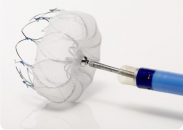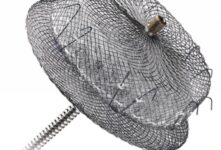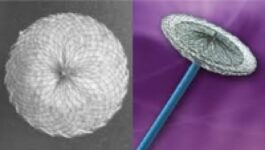Original Title: Transcatheter Tricuspid Valve-in-Valve Implantation for the Treatment of Dysfunctional Surgical Bioprosthetic Valve. An International, Multicenter Registry Study. Reference: Doff B. McElhinney, et al. Circulation 2016;133:1582-93 Courtesy of Dr. Carlos Fava. Transcatheter tricuspid valve in valve implantation (TVIV) is infrequent, complex and biological valves last from 10 to 15 years. Reoperation is associated with high…
Left Atrial Appendage Closure with Watchman Device. 5 Year Outcomes
Original Title: Percutaneous Left Atrial Appendage Closure with the Watchman Device Long-Term Results Up to 5 Years. Reference: Wiebe J, Franke J, Lehn K et al. JACC Cardiovascular Interventions Vol. 8, NO. 15, 2015 Doi: 10.1016/j.jcin.2015.07.040 Courtesy of Dr. Agustín Vecchia. Atrial fibrillation (AF) is one of the most predominant arrhythmias and is associated to cardioembolic…
Cost-Effectiveness of Left Atrial Appendage Closure and the New Anticoagulants vs. Warfarin in Atrial Fibrillation
Original Title: Time to Cost-Effectiveness Following Stroke Reduction Strategies in AF Warfarin vs. NOACs vs. LAA Closure. Reference: Vivek Y. Reddy et al. J Am Coll Cardiol. 2015;66(24):2728-2739. Left atrial appendage closure and the new anticoagulants (NOACs) have emerged as safe and effective alternatives to warfarin for stroke in patients with non-valvular atrial fibrillation. This analysis…
Bleeding Events after Left Atrial Appendage Closure vs. Long Term Warfarin
Original Title: Bleeding Outcomes After Left Atrial Appendage Closure Compared With Long-Term Warfarin A Pooled, Patient-Level Analysis of the WATCHMAN Randomized Trial Experience. Reference: Matthew J. Price et al. J Am Coll Cardiol Intv. 2015. Online before print. The aim of this trial was to compare the relative risk of major bleeding after left atrial appendage closure…
Long-term septal ablation in hypertrophic cardiomyopathy
Original title: Periprocedural Complication and Long-Term Outcome After Alcohol Septal ablation in hypertrofic Obstructive cardiomyopathy. A Single-Center Experience. Reference: Robbert Steggerda, et al. J Am Coll Cardiol Intv 2014;7:1227-34. Septal ablation is an alternative to surgery in hypertrophic cardiomyopathy (HCM), but indications and evolution are not fully established.161 patients who received septal ablation (SA) and 102 who received…
Patent Foramen Ovale: when to indicate closure
References: Matthew Nayor et al. Contemporary Approach to Paradoxical Embolism. Circulation. 2014;129:1892-1897. Marco Hernandez-Enrıquez et al. Current Indications for Percutaneous Closure of Patent Foramen Ovale. Rev Esp Cardiol. 2014;67(8):603–607. The debate on patent foramen ovale behavior in different clinical contexts remains open, no pun intended. Based on numerous observational studies and expert recommendations, when facing the…
Septal ablation, a valid alternative for obstructive hypertrophic cardiomyopathy
Original title: Survival of Patients ≤50 Years Alter Alcohol Septal Ablation for Hypertrofic Obstructive Cardiomyopathy. Reference: Josef Veselka, et al. Canadian Journal of Cardiology 2014,30:634-638 Treatment of symptomatic obstructive hypertrophic cardiomyopathy (HCM) is the surgical septal myomectomy nevertheless, currently arose several studies reporting a favourable evolution and comparable to surgery with septal ablation (AS). 75 patients under 50…
Percutaneous Left Atrial Appendage Suture: more options in atrial fibrillation patients with antiguagulation contraindication
Original title: Percutaneous Left Atrial Appendage Suture Ligation Using the Lariat Device In Patines UIT Atrial Fibrillation Reference: Krystof Bartus, et al. J Am Coll Cardiol 2013;62:108–18. Atrial fibrillation (AF) is the most frequent arrhythmia and is associated with a 5 fold increase in stroke risk and the resulting morbimortality. Warfarin anticoagulation therapy can be effective but only…
Thoracoscopic Stand-Alone Left Atrial Appendectomy
Original title: Thoracoscopic Stand-Alone Left Atrial Appendectomy for Thromboembolism Prevention in Nonvalvular Atrial Fibrilation. Reference: Toshiya Ohtsuka, et al. J Am Coll Cardiol 201362;2:103-107 Anticoagulation is commonly prescribed as prevention therapy against AF-induced thromboembolism. However, even a correct prescription may result in an unexpected stroke due to cardioembolic stroke. Different left atrial appendectomy techniques and devices are currently…
Percutaneous Left Atrial Appendage Closure With the AMPLATZER : a valid alternative when anticoagulation is contraindicated
Original title: Percutaneous Left Atrial Appendage Closure With the AMPLATZER Cardiac Plug Device in Patients With Nonvalvular Atrial Fibrillation and Contraindication to Anticoagulation Therapy Reference: Marina Urena, et al. J Am Coll Cardiol 2013:62:96-102. Anticoagulation is a good therapeutic strategy in nonvascular atrial fibrillation (AF). However, it is contraindicated in approximately 10% of patients, due to the…
Foramen ovale closure for cryptogenic stroke
Original title: Closure of Patent Foramen Ovale versus Medical Therapy after Cryptogenic Stroke. Randomized Evaluation of Recurrent Stroke Comparing PFO Closure to Established Current Standard of Care Treatment (RESPECT). Reference: John D. Carroll et al. N Engl J Med 2013;368:1092-100. It is still unclear if the closure of patent foramen ovale (PFO) is effective in preventing recurrent stroke…










